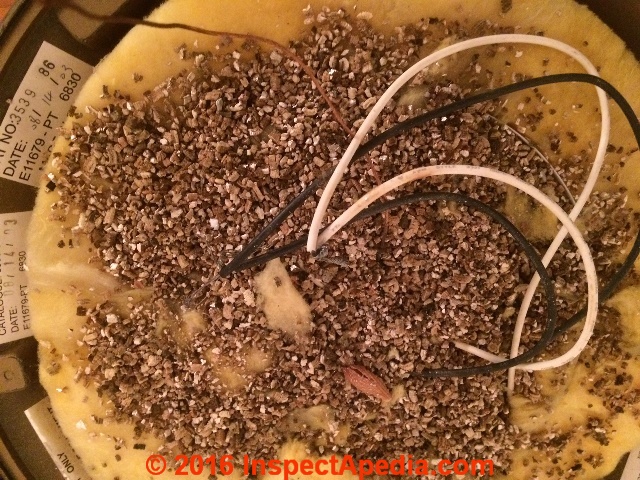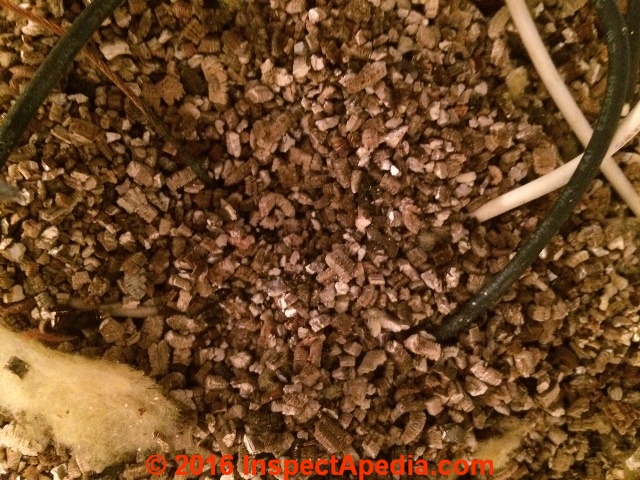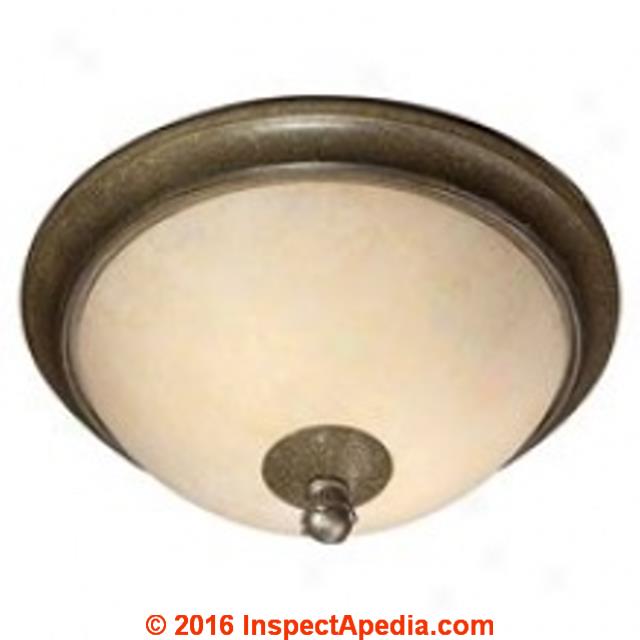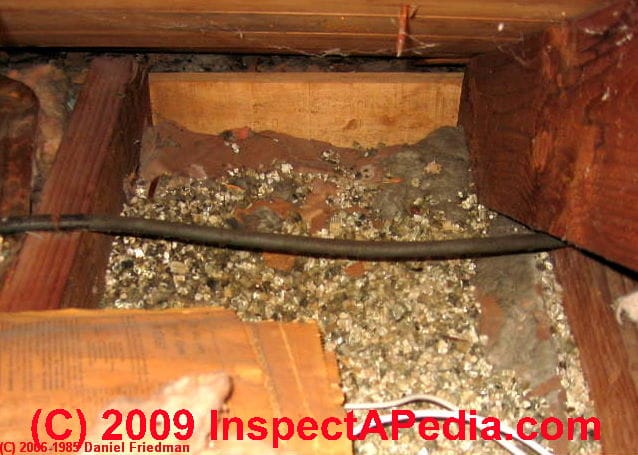 Asbestos Vermiculite Building Insulation FAQs
Asbestos Vermiculite Building Insulation FAQs
Vermiculite identification, location, testing, panic
- POST a QUESTION or COMMENT about vermiculite insulation & asbestos content of vermiculite
Frequently-asked questions and answers about asbestos in vermiculite insulation: what to do about vermiculite insulation that contains or might contain asbestos, how to minimize any asbestos hazards from vermiculite, how to test vermiculite for asbestos, and when and how to remove asbestos-contaminated vermiculite from a building.
This article series explains how to recognize vermiculite building insulation that may contain asbestos fibers.tification of definite, probable, or possible asbestos materials in buildings.
InspectAPedia tolerates no conflicts of interest. We have no relationship with advertisers, products, or services discussed at this website.
- Daniel Friedman, Publisher/Editor/Author - See WHO ARE WE?
Vermiculite Building Insulation: properties, uses, asbestos content

This article series permits visual identification of vermiculite insulation; we include our own as well as US EPA photographs of various forms of vermiculite insulation to assist in recognizing vermiculite in buildings.
These questions & answers about handling possible asbestos hazards in vermiculite building insulation were posted originally
Article Contents
- DISTURBING VERMICULITE INSULATION FAQs - avoid making a dusty mess
- DON'T PANIC ABOUT VERMICULITE FAQs
- HOW VERMICULITE ASBESTOS DUST BECOMES AIRBORNE FAQs
- LEVELS of ASBESTOS in VERMICULITE FAQs
- OTHER INSULATION THAT'S NOT VERMICULITE FAQs - don't mistake these for vermiculite
- VERMICULITE INSULATION ASBESTOS TEST FAQs
- WHAT DO I DO ABOUT VERMICLITE INSULATION FAQs
- WHAT DOES VERMICULITE LOOK LIKE FAQs
- WHERE MIGHT VERMICULITE BE FOUND IN BUILDINGS FAQs
...
What do I Do About Vermiculite FAQs
What should I do if I have vermiculite insulation in my building ?
Quoting & paraphrasing or elaborating further from the U.S. EPA information on Vermiculite[5]:
You should assume that the vermiculite insulation contains asbestos and it should not be disturbed. Particularly, do not stir up nor spread dust from this product!
Any disturbance could potentially release asbestos fibers into the air. If you absolutely have to go in your attic and it contains vermiculite insulation, you should limit the number of trips you make and shorten the length of those trips in order to help limit your potential exposure.
We and the US EPA recommend that you:
- Leave vermiculite insulation undisturbed in your attic or in your walls.
- Do not store boxes or other items in your attic if it contains vermiculite insulation.
- Do not allow children to play in an attic with vermiculite insulation.
- Do not attempt to remove the vermiculite insulation yourself.
- Hire a professional asbestos contractor if you plan to remodel or conduct renovations that would disturb the vermiculite in your attic or walls to make sure the material is safely handled and/or removed.
- [If substantial costs are involved in handling or removing any building product suspected of containing asbestos, particularly friable asbestos that can easily be spread through a building as airborne dust, you should have the material tested to confirm its asbestos content and in order to understand what special handling may be required. ] - Ed.
For more details about the inspection and detection of concerns with fiberglass building insulation, see:INSULATION INSPECTION & IMPROVEMENT and FIBERGLASS HAZARDS .
Our separate websites on FIBERGLASS BUILDING INSULATION and or series of articles about HVAC DUCT WORK DEFECTS contain in-depth discussion about possible air quality and health concerns which may be associated with exposure to fiberglass dust.To compare insulating material R-values of fiberglass in various forms as well as other insulating materials, see our Table of Properties of Insulating Materials
Also see these U.S. & Canadian Guides to Asbestos-Hazards in Vermiculite Insulation
- VERMICULITE: PROTECT YOUR FAMILY FROM ASBESTOS-CONTAMINATED VERMICULITE INSULATION, U.S. EPA, [PDF]
- PROTEJA SU FAMILIA DEL AISLANTE DE VERMICULITA CONTAMINADO CON ASBESTOS, U.S. EPA [PDF]
- CURRENT BEST PRACTICES FOR VERMICULITE ATTIC INSULATION - May 2003, U.S. EPA
- VERMICULITE INSULATION CONTAINING AMPHIBOLE ASBESTOS - September 2009, Health Canada
- WHAT TO DO ABOUT VERMICULITE INSULATION
...
How Vermiculite Attic Insulation Becomes Airborne FAQs
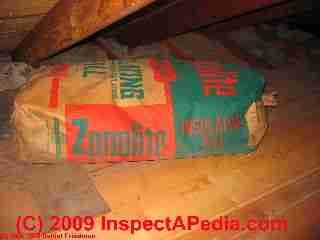 Any airborne dust particles can be a respiratory irritant, but the hazard level is likely to be increased if the dust contains insect or rodent materials and of course also if it contains asbestos as is present in some vermiculite insulation installations.
Any airborne dust particles can be a respiratory irritant, but the hazard level is likely to be increased if the dust contains insect or rodent materials and of course also if it contains asbestos as is present in some vermiculite insulation installations.
Particularly where loose fill vermiculite insulation remains exposed in an attic, such as in the attic floor, the following act ivies are likely to cause dust from this product to become airborne.
- Operating a whole house fan or an attic vent fan
- Walking on or near the vermiculite insulation
- Disturbing the vermiculite insulation during building remodeling, renovations, or roofing work
- Storing items on the vermiculite insulation - which risks transporting dust out of the attic into the living space if those items are then brought into the occupied space below
You can reduce these dust risks by installing a plywood floor over the tops of the floor joists (ceiling joists of the rooms below), by installing fiberglass batts on top of the vermiculite, or by spraying an acrylic encapsulant on the exposed surface of the vermiculite in the attic.
Watch out: spray-coating the upper surface of an attic insulation material installed in the floor risks creating a vapor barrier on the wrong side (the cold side) of the structure, trapping moisture and leading to condensation or even mold troubles.
...
Scared About Vermiculite FAQs
I am in a panic about vermiculite in my attic - what do I do?
I had my attic cleaned out, then vacuumed, then I had a central A/C system installed. The insulation guy gave me a quote prior to AC install. They came out afterward and started to blow in insulation and ran out saying there was this vermiculite stuff.
I had never heard of it. So now what? My grandson was here while they installed A/C which included cutting the drywall to put in the vents. I've run this system, its a closed system. People have been walking in and out of my attic. I AM FREAKING THE F**K OUT. What do I do? I keep reading so many conflicting things. HELP PLEASE. - Anonymous by private email 2017/12/28
Reply: Four Steps to get Vermiculite-Asbestos Worries Under Control
- There is no reason to panic nor to succumb to your insulators "running out of the home in fear" which to me sounds a bit exaggerated or manipulative. There is also the OPM problem - spending your money to reduce their risk -
see OTHER PEOPLE's MONEY - Not all vermiculte contains asbestos- before spending anything significant on the topic I would have a sample tested for asbestos -
see ASBESTOS TESTING LAB LIST - Meanwhile, avoid making more of a dusty mess and avoid tracking dust out of attic into the home.
Do not make further use of a home or shop vacuum cleaner that is not HEPA-rated when vacuuming up dust that you suspect may contain asbestos as such vacuum cleaners increase the level of airborne dust. Instead use damp wiping or use a HEPA-rated vacuum cleaner.
See VERMICULITE INSULATION for more information about identifying vermiculite insulation. - See WHAT TO DO ABOUT VERMICULITE INSULATION for advice about reducing the risk of asbestos hazards from vermiculite insulation in your building.
Worried that I may have been exposed to asbestos after finding some white stuff in a box
I found a box in back of my cluttered closet that i keep my every day clothes in the box i found a metal iron rest with a caulky white material some pieces were damaged from age but in a panic i put in a plastic bag and put it outside.
I put on a respirator mask wet down the closet with spray bottle of soap and water washed all of my cloths, and wiped down boxes and bags mopped the whole house with disposable pads.
This was 6 months ago but i am still worried that i exposed myself to abestos.and i wii get sick. Help in panic mode Thank you On 2019-03-26 by joe m. -
Reply by (mod) -
Joe
I can't assert from your note that your box contained asbestos materials but surely if you cleaned up as you described your response was reasonable. If you're still worried you might collect a representative sample or two of settled dust from your living area to have tested by a certified asbestos test lab - check the page top EXPERTS DIRECTORY
...
Asbestos Levels in Vermiculite FAQs
Is .0004% of asbestos ok to be working in and preparing food in?
I work in a school in MT [Montana in the USA], and 2 years ago this substance was removed from two rooms in the school, one which is right by the kitchen i work in. well 2 days ago i found this substance on top the the cupboards and everywhere else, and can see that it is falling from the ceiling.
Very concerned because i have a fan blowing in there, and there was asbestos in the school when they came and had it cleaned. my question to you is, is .0004% of asbestos ok to be working in and preparing food in?
i truly found this site excellent, it answered alot except that one question. thank you - Amy Swanson 9/2/11
Reply:
Thanks for the nice note Amy.
A proper asbestos cleanup project, especially in a school, should have included post-cleanup inspecting and testing to assure that no asbestos hazard remained. You might want to ask for and read that report.
About the substance falling from your ceiling, if you think it's asbestos-containing material you certainly shouldn't be running a fan, and it would make sense to have it tested for asbestos content.
The % of asbestos number you cite leaves me confused. If you mean that the general dust from the environment is down to that minimal level, it sounds almost below the limits of detection. But I don't know what test you are describing, nor where nor how it was performed -those questions are key in understanding what the test results mean.
Your concern should be answered more specifically by a hygienist or similar professional who has specific expertise in asbestos and indoor air quality and who knows the building and its history.
We would much appreciate hearing any comments, critique, suggestions, or further questions from you or other readers. We are dedicated to making our information as accurate, complete, useful, and unbiased as possible: we very much welcome critique, questions, or content suggestions for our web articles. Working together and exchanging information makes us better informed than any individual can be working alone.Reader follow-up:
Well this is my first year at this school, and was told that 2 years ago there was asbestos in the library and the music room and they did have it cleaned up professionally, but they didn't do it to the kitchen.
now this stuff that looks like your picture above with the gold and silver flakes in is is all over my kitchen and my boss told me it wasn't harmful cause they had it tested and it was at .0004%, but my concern is that if they had to clean it out of the other 2 rooms that it should be also done to my kitchen
and i have 2 other ladies that work with me and we are all really concerned and are wondering what it is or whom it is that we can contact because everyone is telling us its ok and i don't think it is ok.
my boss is having someone come out there to caulk the ceiling again, and that is it...more or less just sweeping this under the rug. ..i have some of this stuff that fell from the ceiling in a plastic folder. it was hanging on the wall and caught it, but my concern is that i didn't know it was in there at the time i pulled a few papers out of it.
that is how it was brought to my attention of what it was. i am seriously concerned and would just like to know whom it is i need to contact outside the school, since no one in the school seems to really care about it or us.
...
Where is Vermiculite Found in Buildings FAQs
Was Vermiculite insulation used in light fixtures?
Reader comment/question: Your website is terrific and very helpful. I was on there to try to identify something. We removed a front hall lamp, by the entrance, and found some wood like droppings inside the lamp. Please see attached photos.
We are not sure what this is but are concerned that it could be dry wood termite droppings. Any ideas? - Anonymous by private email, 2016/09/19
Reply:
What your photos show looks very much like vermiculite insulation -
Anon said:
I will send you a photo of the light fixture when I return home (just writing from the office). The house was built in 1934 (plaster walls, etc.). The light fixture looks something like this (picture from the internet):
Mod said:
OK now I understand: that ceiling light fixture is insulating its heat from the ceiling above, perhaps for added fire safety. I look forward to seeing actual photos and with your OK will add this info to our vermiculite and light fixture articles as that will help other readers.
Beware that some vermiculite contains asbestos - avoid making a dusty mess and use damp wiping not a household vacuum cleaner for any spill cleanup.
Anon said:
Would you suggest we have the vermiculite tested for asbestos? We kept a sample.
Mod said:
No. The volume of such a small amount of insulation and thus the hazard are rather small. It wouldn't change what you do.
Ever seen vermiculite insulation in a cathedral ceiling ?
I have a 1960 house. Have you ever seen vermiculite insulation in a cathedral ceiling ? On 2020-03-12 by Anon
Reply by (mod) -
Anon
Vermiculite in a cathedral ceiling is possible, though certainly not a first choice as in the form of a loose- fill insulation, it's a bit difficult to install there.
...
What does Vermiculite Look Like FAQs
Does this look like vermiculite?
I found this taking off ceiling in an old house thoughts? Just stuff on top of the square ceiling tile. Thought it was mouse stuff but researching.. may not be thks On 2021-03-21
by Rob -
Reply by (mod)
@Rob, that looks like vermiculite insulation
...
Don't Mistake This for Vermiculite
Is this Sears Homart Rock Wool Insulation Vermiculite?
I can't find ANY information on vermiculite from Homart and Sears (best of all insulation) I found 2 bags in my attic and will be sending it out for a test but was trying to find some product info in the meantime. I'm attaching pics if anyone has information it would be greatly appreciated On 2021-02-02 by coleman -
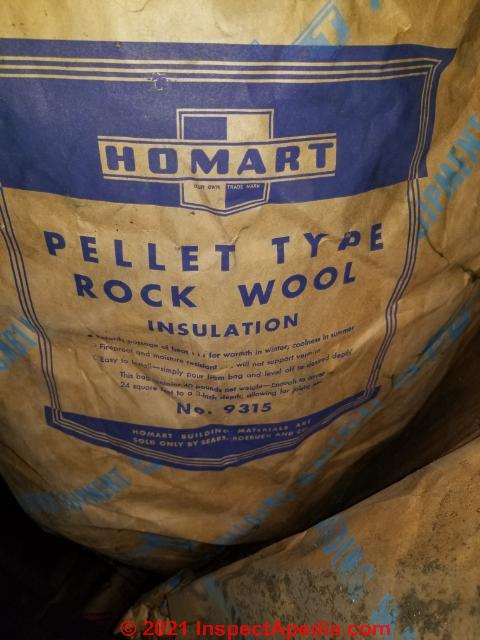
Here is the Sears best of all insulation bag [ shown above ]
Reply by (mod) - don't confuse mineral wool or rock wool with vermiculite insulation
Coleman, thank you for the photos of Sears Best "Mineral Fill" insulation, and your photo of Sears Homart Pellet Type Rock Wool Insulation - we will certainly keep these with this article series.
Typically national brands like Sears contracted to buy their materials from more than one supplier, depending on availability and price; so it is possible that **IF** you have vermiculite insulation sold by Sears, that least some Sears vermiculite came from the Libby mine; until I can find more specific details it would be prudent to treat the Sears Vermiculite as presumed to contain asbestos.Really? Well not quite. Both of your packages describe insulation that may not be vermiculite at all but rather mineral wool or rock wool.
Certainly the Sears Pellet Type Rock Wool is likely to be mineral wool not vermiculite, and
Your Sears Roebuck Best of All Insulation package labeling describes the product as "Mineral Fill" - that may be mineral wool, too.
Please post a photo of what the actual insulation itself looks like so that we can confirm what it is.
Rock Wool or mineral wool insulation is not a vermiculite product.
See details at MINERAL WOOL IDENTIFICATION, APPEARANCE VARIATIONS
Johns- Manville Spintex "Blown" Home Insulation - vermiculite?
I see no mention of Johns- Manville Spintex "Blown" Home Insulation. Does it contain asbestos? It was a vermiculite looking material that was blown into wall spaces in the 1950's in Pennsylvania. On 2019-01-11 by Ann Markley -
Reply by (mod) - Mansville SpinTex is not vermiculite
Ann:
SpinTex is mineral wool, not vermiculite, that's why we didn't discuss it in this article.
Take a look at
MINERAL WOOL - ROCK WOOL INSULATION
Is there asbestos in Zonolite Rolled Glass Fiber Home Insulation
I got zonolite rolled glass fiber home insulation is it safe ? - Concerned
Reply: fiberglass is not an asbestos material
Concerned: I don't recognize the product you name - can you send me a photo of the material and of any labels or markings on packaging? Then I can research and comment further. Use the CONTACT US link at page top or bottom to send photos if you can.
Certainly "fiberglass" is not an asbestos material. In our opinion, fiberglass insulation is safe if it has been properly installed and has not been damaged. Severely damaged fiberglass insulation, such as a product that has been walked-upon numerous times, or that has been macerated during demolition, may produce high levels of glass fiber dust, including small particles that may are a respiratory irritant and may be more harmful.
Insulation in a 1969 house looks like white and gray furry stuff - is this vermiculite or asbestos?
I am buying a house that was build in 1969. I have not tested the insulation yet (I will). However, it doesn't looks like any of the above pictures. It looks like white and gray and furry. Are there still chance for the insulation to contain vermiculite or asbestos? - Will 7/12/2012
Reply:
Will,
For help in identifying the type of insulation in your home, see our INSULATION IDENTIFICATION GUIDE From your description you may be looking at Mineral Wool - Rock Wool Insulation.
Was asbestos-contaminated vermiculite imported into the U.K.?
Are you aware if any of this contaminated vermiculite was imported to the UK? Thank you. - Laurence 9/15/2012
Reply:
Sorry Laurence, no I don't know.
Typically, because of price competition and the importance of shipping costs, insulation products are produced and shipped from locations a bit closer to their point of use.
...
Vermiculite Insulation Asbestos Test FAQs
Where can I have a sample of vermiculite insulation to have it tested?
I recently purchased a house from HUD. I had my home inspected and found out there is exposed vermiculite in the basement that has fallen to the floor and is now been tracked around. Where can I take a sample of this insulation to have it tested ? - Tim 9/16/2012
Reply: Where to Find a Certified or Accredited Asbestos Testing Laboratory
Tim, you can use any test laboratory certified for asbestos testing. Both the US EPA and many U.S. states or Canadian provinces maintain lists of currently-approved asbestos testing labs.
Most state and provincial governments regulate and certify asbestos testing laboratories, and we recommend that where there are health, legal, or cost concerns, you should only use a certified and competent asbestos testing laboratory to examine material samples for asbestos content.
We give a list of several ways to find a certified asbestos test lab at ASBESTOS TEST LABS.
Should I have my Attic Insulation Tested?
I found plastic bags in my attic space that say "Full Fill" Insulation 100% abestos free from Koos Inc. Kenosha, WI. Should I have the insulation tested? - Colleen 3/4/12
Reply: U.S. EPA Koos WI Site Visit Report on Vermiculite & Asbestos Exposure
Colleen, some mesothelioma and asbestosis websites, usually ones seeking to provide legal services, report that workers at Koos corporation in Wisconsin were exposed to dangerous levels of asbestos. The U.S. EPA visited the Koos site in Kenosha, WI on 9 March 2000. Here are two reports from the U.S. Government Accounting Office.
Unknown facility:
An EPA database compiled from W.R. Grace shipping invoices did not contain any records indicating Libby ore was shipped to this site. Because this site was associated with the Koos Inc. site in Kenosha, Wisconsin, EPA visited this site.
(The Kenosha site is listed separately in this database) At the time of EPA's visit, IMC Salt, Inc. operated at this site. The company warehoused and distributed packaged salt. According to company officials, IMC started operations at the site in 1995. Company officials were not aware of vermiculite ore being handled at this facility. EPA did not find any records indicating that Koos had operated at this site before 1995. On the basis of this information, EPA determined no further action was needed.[19]
Former Koos Inc. exfoliation facility, asbestos, & vermiculite
According to an EPA database compiled from W.R. Grace shipping invoices, 1,995 tons of vermiculite ore from the Libby mine were shipped to this site between April 1969 and March 1982.
In addition, reports published by the U.S. Geological Survey in 1975, 1980, 1985, and 1990 indicated that this facility had been a vermiculite exfoliation plant.The site was about 10 acres and was bounded to the north by a street, to the east by railroad tracks, and to the west and south by businesses and residences. At the time of EPA's site visit, IMC Salt, Inc. was operating at the site. The site consisted of an office building, a warehouse and production area, a bulk storage building, and a maintenance shop.
According to IMC officials, IMC Vigaro purchased Koos, Inc. in 1995 and all exfoliation equipment was sold at that time. In 1998, IMC Salt, Inc. began salt packaging and warehousing operations at the site.
From 1960 until 1995, Koos had exfoliated vermiculite at the facility and sold vermiculite wholesale. Exfoliated vermiculite was sold for use in fertilizer and in fire proof doors. Some of the exfoliated vermiculite waste had been placed in a local landfill.
An IMC official said Koos purchased vermiculite ore from American Vermiculite (a South African mine) and from W.R. Grace, but, to their knowledge, none of the ore came from the Libby mine. The ore was shipped to the facility by truck and rail and the exfoliation process was performed indoors
. EPA did not see any evidence of vermiculite on the site. On April 3, 2001, EPA collected five soil samples at the site and analyzed them using polarized light microscopy (PLM). None of the samples contained detectable levels of asbestos. On the basis of this information, EPA decided no further action was needed.[20]
Therefore, while the "safe answer" is to spend your money testing your insulation, and given only the information in your brief question, we caution that as we report in detail in the article above, even if your insulation is a vermiculite product (you did not say that it was), a bulk test can give a false negative result.
Therefore the EPA and other experts advise that consumers assume that their vermiculite contains asbestos and follow EPA's advice to leave the material alone, undisturbed.
Gold Nugget brand vermiculite found in a home in Vancouver BC - no asbestos detected
Regarding "Gold Nugget" brand Vermiculite, it does exist. I found vermiculite in the attic of a home just purchased and mixed in was part of the paper bag label showing that name. This is in Vancouver, BC.
FWIW, this tested as completely negative for asbestos, so safe to say at least some of it did not come from the Libby mine. On 2016-08-26 by Robert in Vancouver -
Ontario vermiculite found to contain 0.3% asbestos
My attic tested .3% asbestos containing vermiculite in Ontario. The mandated reporting level here is .5%. Does that mean I can say my attic is asbestos free?
Thanks On 2016-04-21
by Paul
Reply by (mod) - 0.3% asbestos is not "asbestos free"
Paul,
In my opinion, absolutely not. 0.3% asbestos is not "asbestos free"
Keep in mind that because asbestos won't be perfectly uniformly distributed in an insulation sample of vermiculite, and because even in the lab, just how the sub-sample portion is selected for examination, we cannot assume that two successive tests will produce identical results, nor that another test of your vermiculite might be well above 0.5%.
What are the chances that vermiculite in our home came from the Libby Mine?
I have a house in Massachusetts that was constructed circa 1770. Local lore has it that there was an attic fire circa 1890. The wood work and plaster indicate that the attic was "finished" circa 1900. Some floor boards are missing, the floorboards are 1" hard pine, T&G.
They also indicate late 19th, early 20th century. The floorboards were removed in the 1950's for electrical wiring (I am certain vermiculite was not added at that time). I can see about 1 1/2 inches of vermiculite between the joists.
I have spoken with a local resident who grew up in the house in the 1940's, when it did not have electricity. He tells me that heat was by way of a hot air furnace in the cellar which released heat through a large grate in the first floor. This also indicates late 19th century. I would assume that was when any attic insulation was added.
So,my question is. given the era what is the likelihood that the vermiculite came from the Libby mine which contained the asbestos? - Ralph Donaldson 5/5/12
Reply:
Ralph,
Considering the very wide-spread use of Zonolite as a retrofit building insulation product, it is certainly possible that it was used in your home. Zonolite, which was found to contain tremolite asbestos, was produced in very large quantities, reaching 150,000 tons per year by 1950, and the plant continued to operate until 1990.There are other vermiculite mines that do not contain asbestos in their product and that continue to operate today.
It would be a mistake to presume that the Libby Montana Zonolite vermiculite mine source was the only source of asbestos containing products, including insulation, found in homes, as asbestos was used in a very wide range of building and in-home products and continues to appear in some products today. And it might be an error to presume this is the most serious hazard in a home as well.
In our article above we report in detail on the occurrence of asbestos in Zonolite Attic Insulation (ZAI) produced by the Zonolite Company and by its successor owner- W.R. Grace Corporation between 1923 and 1990.Watch out: It might be useful to have your vermiculite insulation tested. If the result shows Tremolite asbestos (vermiculite mined at Libby Montana had a 10% Tremolite asbestos content) that probably points to the Libby vermiculite mine.
But the US EPA warns that bulk testing of vermiculite for asbestos content can sometimes lead to a false negative finding (failing to detect asbestos even though it is present). That's a reason that the US EPA warned that people should err on the side of caution, assuming that it is asbestos-contaminated.
We also are researching the question of whether or not one can report a contents profile that would let one assay a vermiculite sample and guess at its source - as can be done very accurately with roofing slates. We will add that information here.
Worried sick after our home inspector tested our "vermiculite insulation" for asbestos - lab said it was cellulose
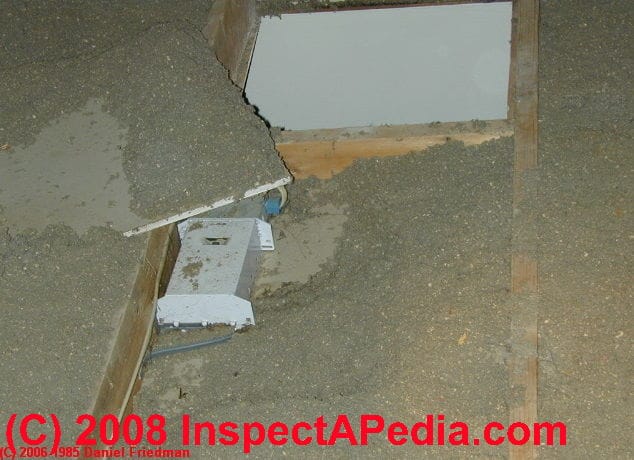 I recently bought a 1940s house which upon inspection was suspected to have vermiculita in a small area of the attic.
I recently bought a 1940s house which upon inspection was suspected to have vermiculita in a small area of the attic.
The home inspector got it tested and it came back composed of cellulose and non fibrous materials, no asbestos. fast forward a few months we are now having our batting insulation replaced and the guys doing the work tell us its vermiculite.
What do we go by? we also had our contractor tell us that its not vermiculite...im worried sick that now that the batting insulation is being removed, asbestos fibers might flying all over our house! - Worried sick., 10/5/2012
Reply: cellulose is not vermiculite and is not asbestos; but one insulation sample may not represent all building insulation in the structure
Worried:
You might be best off trying to not be worried sick, as that itself may be an immediate health hazard and also invites opportunists who may price-gouge you when they see that you're terrified. Scared means costly.
Provided your home inspector used a qualified forensic or asbestos test lab (see Where to Find a Certified or Accredited Asbestos Testing Laboratory), I'd trust their lab result for the insulation sample that was actually tested.
I am very surprised that your home inspector could not himself tell the very obvious difference between cellulose building insulation and vermiculite insulation.
Cellulose and vermiculite are even slightly similar.
Why did he test cellulose (CELLULOSE LOOSE FILL INSULATION [Web article] it's basically paper) for asbestos? Did he charge you a profit beyond the actual lab fee for that test? (Was there a conflict of interest here?)
I am not surprised that workers may have found vermiculite insulation in a 1940's house; Vermiculite was widely used as a pour-in insulation retrofit and often a 1940's home was originally built with little or no insulation to start with.
In the 1970's many of us (including myself) added various insulation products, including vermiculite, in those homes.By taking a look at the photographs in this article, even a child should be able to see the difference between vermiculite and other building insulation products. Our photo above shows a typical blown-in cellulose insulation installation.
If indeed your workers are correct and vermiculite is in place, you should
- Stop any work on the building that is or is likely to disturb the material and then
- Follow the advice at Protect Your Family from Asbestos-Contaminated Vermiculite Insulation [Article]
- If someone has already made a dusty mess in the home, extra cleaning measures such as damp-wiping and HEPA vacuuming are probably in order, asbestos-containing-vermiculite or not.
How do I make sure that the home has not been contaminated with asbestos?
I hope you can help me with a query I have. [Paraphrasing at reader request]: there was a vermiculite spill in my home in Ireland.
How do I make sure that the home has not been contaminated with asbestos?
Reply: Dust sampling theory: usefulness & definitions of "old dust" and "recent dust" in buildings & where these are found
In an effort to be more clear about dust sampling theory I have expanded the descriptions of old dust, recent dust, where such samples are usually found, and why one would collect them for analysis - that discussion is now found at
DUST SAMPLE TYPES
In short, if you were worried that an original vermiculite spill had not been adequately cleaned, *or* if you wanted to know if the original vermiculite spill included asbestos, you might want to collect both a recent-dust sample and an old dust sample for comparison.
If, however, the cleanup was professionally conducted and post-cleanup testing was already performed properly, and if those steps indicated no problem remaining, in my *opinion* further testing would not be justified unless a new reason for further investigation is apparent.Examples of such reasons are at MOLD / ENVIRONMENTAL EXPERT, HIRE ?
and also at MOLD TEST REASONS.
Reader follow-up:
The vermiculite spill was not professionally cleaned, and was swept and vacuumed with a standard household vacuum cleaner by the plumber before I ever knew what vermiculite was
Reply:
Thanks for the follow-up; Ordinary vacuuming actually increases the level of fine particulates; HEPA vacuuming would have been in order if we thought that asbestos was present, along with damp wiping of horizontal surfaces.
Most likely, from your case history, you're ok. If you want to get a settled-dust sample analyzed just send it to a certified asbestos testing laboratory and allow them to choose their method of analysis; typically the lab uses polarized light microscopy following the Walter McCrone procedure.
Some asbestos test labs may also make use of other methods such as SEM; any certified lab will use appropriate asbestos identification procedures - as an amateur I would not second guess the lab ty telling them what to do, just make sure the sample is collected and question posed following their requrested procedure.
...
Disturbing Vermiculite Insulation FAQs
Replacing roof shingles after our attic vermiculite tested positive for Libby Amphibole
We had our vermiculite attic insulation tested and it came back as positive for Libby amphibole. Prior to finding this out, we had our roof shingles replaced. I was wondering if that would be considered a disturbance to the vermiculite? On 2017-01-20 by Megan
Reply by (mod) -
Megan
Replacing roof shingles involves pounding that can perhaps do a bit of dust stir-up. Just how much of that would move into the occupied space is questionable, though not an impossibility.Normally building air moves up and out by convection currents though there a few exceptions. Foot traffic, walking in and out of an attic would be a similar possible means of moving dust from that space to the occupied space.
Overall, the roofing work is, I speculate, a low concern.But if your particular home is at risk or you have high concern, I suggest simply collecting a representative sample or two of settled dust from indoor surfaces in the occupied space - perhaps on the floor below the attic or below the attic access stair or hatch in particular, or below other openings between attic and occupied space.
Send that to a qualified lab liek the one who tested your vermiculite insulation and ask for an identification of the dominant particles and for an assessment of the level of asbestos in the dust.
Do keep us posted as what you learn may help others.
Robert in Vancouver: I agree for certain that Gold Nugget brand of vermiculte insulation "exists" - as it's not likely that every home where such insulation was installed has had it removed/replaced.
...
...
Continue reading at VERMICULITE INSULATION or select a topic from the closely-related articles below, or see the complete ARTICLE INDEX.
Or see these
Recommended Articles
- ASBESTOS STYROFOAM PANELS
- ASBESTOS TESTING LAB LIST
- INSULATION IDENTIFICATION GUIDE
- VERMICULITE INSULATION - home
- HOW TO IDENTIFY VERMICULITE INSULATION - separate article
- VERMICULITE HISTORY & PROPERTIES
- WHAT TO DO ABOUT VERMICULITE INSULATION
- ZONOLITE BRAND VERMIULITE INSULATION ZAI & CLAIMS
- MICA-FIL, MUNN & STEELE, CALIFORNIA, CANADA, & SISCO VERMICULITE ASBESTOS
- VERMICULITE INSULATION INCIDENTAL EXPOSURE HAZARDS ?
Suggested citation for this web page
VERMICULITE INSULATION FAQs at InspectApedia.com - online encyclopedia of building & environmental inspection, testing, diagnosis, repair, & problem prevention advice.
Or see this
INDEX to RELATED ARTICLES: ARTICLE INDEX to ASBESTOS HAZARDS
Or use the SEARCH BOX found below to Ask a Question or Search InspectApedia
Ask a Question or Search InspectApedia
Try the search box just below, or if you prefer, post a question or comment in the Comments box below and we will respond promptly.
Search the InspectApedia website
Note: appearance of your Comment below may be delayed: if your comment contains an image, photograph, web link, or text that looks to the software as if it might be a web link, your posting will appear after it has been approved by a moderator. Apologies for the delay.
Only one image can be added per comment but you can post as many comments, and therefore images, as you like.
You will not receive a notification when a response to your question has been posted.
Please bookmark this page to make it easy for you to check back for our response.
IF above you see "Comment Form is loading comments..." then COMMENT BOX - countable.ca / bawkbox.com IS NOT WORKING.
In any case you are welcome to send an email directly to us at InspectApedia.com at editor@inspectApedia.com
We'll reply to you directly. Please help us help you by noting, in your email, the URL of the InspectApedia page where you wanted to comment.
Citations & References
In addition to any citations in the article above, a full list is available on request.
- In addition to citations & references found in this article, see the research citations given at the end of the related articles found at our suggested
CONTINUE READING or RECOMMENDED ARTICLES.
- Carson, Dunlop & Associates Ltd., 120 Carlton Street Suite 407, Toronto ON M5A 4K2. Tel: (416) 964-9415 1-800-268-7070 Email: info@carsondunlop.com. Alan Carson is a past president of ASHI, the American Society of Home Inspectors.
Thanks to Alan Carson and Bob Dunlop, for permission for InspectAPedia to use text excerpts from The HOME REFERENCE BOOK - the Encyclopedia of Homes and to use illustrations from The ILLUSTRATED HOME .
Carson Dunlop Associates provides extensive home inspection education and report writing material. In gratitude we provide links to tsome Carson Dunlop Associates products and services.


